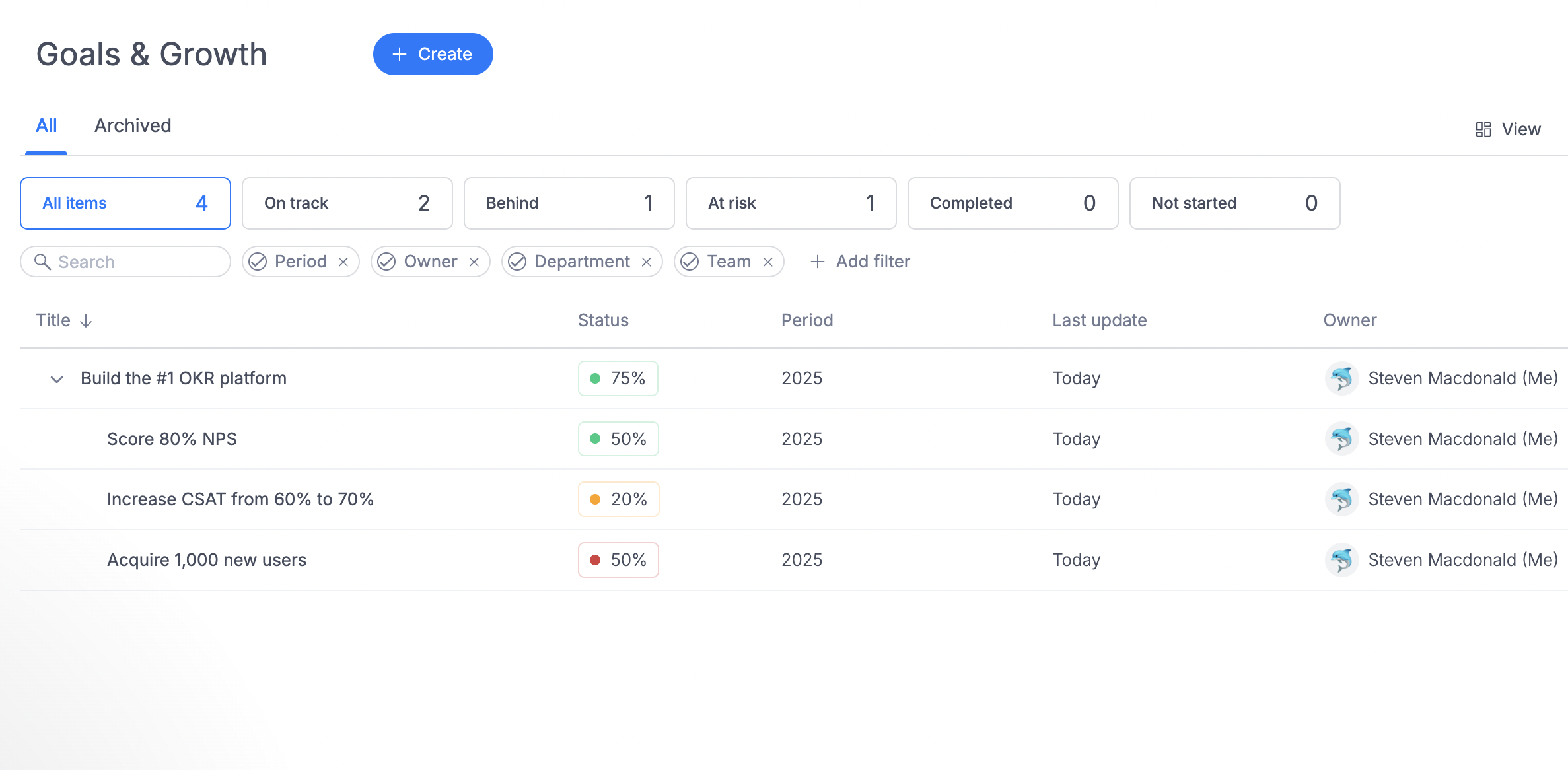When WorkBoard acquired Quantive in May 2025, the OKR world took notice.
Quantive had built a loyal following among startups and growth-stage companies for its blend of OKRs, KPI tracking, and strategic alignment. But after the acquisition, its direction changed.
The result? A more enterprise-focused platform - and a growing number of early-stage teams searching for something simpler, faster, and more affordable.
Quantive’s new model includes:
- A full product migration into WorkBoard
- Enterprise-tier pricing and licensing
- Changes to UI, features, and roadmap focus
- Uncertainty around data hosting, compliance, and support
For startups that once relied on Quantive’s accessibility, the move left a gap in the market - one that’s quickly being filled by leaner, more affordable OKR software.
Why Are Startups and Mid-Size Teams Leaving Quantive?
The answer isn’t just price. It’s philosophy.
Quantive’s evolution under WorkBoard has shifted its focus toward top-down strategy execution - powerful, but heavy. Startups, on the other hand, thrive on tools that are lightweight, self-serve, and quick to adapt.
Three common pain points have emerged:
- Enterprise bloat: Teams feel buried under too many dashboards and layers.
- Per-seat pricing: Growth now means skyrocketing costs.
- Loss of autonomy: Smaller teams want to own their process, not fit into an enterprise mold.
Sound familiar? Thousands of Quantive users are exploring simpler OKR tools that bring back agility - without sacrificing alignment or progress tracking.
The Best Quantive Alternatives for 2026
We tested dozens of free OKR platforms to find the nine best alternatives that capture what startups loved about Quantive - focus, visibility, and momentum - while staying lean and affordable.
1. OKRs Tool - Best Overall Alternative for Startups

Why it’s a great alternative:
OKRs Tool delivers everything startups loved about Quantive - alignment, visibility, and accountability - but without enterprise clutter. It’s built specifically for small and remote-first teams that value speed, clarity, and affordability.
The tool includes AI-generated OKRs, weekly async check-ins, and hierarchical OKRs to link goals together - all wrapped in a clean, intuitive interface. Its flat pricing model means you pay for your organization, not per seat.
Highlights:
- AI-generated objectives and key results
- Team-based flat pricing
- Slack integration for async updates
- Hierarchical OKRs to link company-wide goals
Free plan: Free for up to 10 users
Best for: Startups that want OKRs that stick without admin overhead
2. Weekdone - Best for Weekly Alignment

Why it’s a great alternative:
Weekdone keeps teams aligned through short weekly reporting cycles - a format that echoes Quantive’s rhythm of accountability but with more simplicity. For small teams, it’s a no-fuss way to stay on track and discuss progress.
The tool blends progress visualization with lightweight team updates. Managers can quickly see what’s moving, what’s blocked, and what needs support - all without a full enterprise rollout.
Highlights:
- Weekly reporting and progress tracking
- Goal alignment across teams
- Simple visual dashboards
Free plan: Free for up to 3 users
Best for: Small teams establishing OKR habits
3. Perdoo - Best for Strategy and KPI Alignment

Why it’s a great alternative:
Perdoo offers the same strategy-meets-performance approach that Quantive pioneered. It lets you connect OKRs to KPIs, visualize dependencies in strategy maps, and link company-level objectives to team outcomes.
While it’s more structured than some free tools, Perdoo is ideal for founders who want to tie OKRs to measurable impact while keeping strategy front and center.
Highlights:
- Strategy map visualization
- OKR and KPI integration
- “Give Kudos” feedback and recognition
Free plan: Free for up to 5 users
Best for: Startups bridging strategic and performance goals.
4. Synergita - Best for Linking OKRs and People Development

Why it’s a great alternative:
If you used Quantive for performance management, Synergita fills that niche beautifully. It merges OKRs with employee growth and engagement, making it a great fit for scaling teams that want to link personal development with business outcomes.
The interface is simple, and feedback loops are built in, making it easier to track both what’s achieved and how it’s achieved.
Highlights:
- Continuous feedback + OKR tracking
- Integrated performance reviews
- Employee growth plans
Free plan: Free forever (limited objectives)
Best for: People-centric startups investing in culture
5. SugarOKR - Best for Simplicity and Speed

Why it’s a great alternative:
SugarOKR strips OKRs down to their essentials - fast setup, clear color-coded tracking, and instant alignment. It’s a strong choice for startups that don’t need layers of dashboards and analytics, just a simple way to track what matters.
Highlights:
- Lightweight setup
- Real-time visual updates
- Perfect for goal reviews and team syncs
Free plan: Free with core OKR features
Best for: Early-stage teams wanting clarity and speed
6. Primalogik - Best for Feedback + Goal Alignment

Why it’s a great alternative:
Primalogik brings OKRs and 360° feedback together, giving startups a framework for both performance and alignment. It’s perfect for teams that want OKRs to inform coaching and reviews - a bridge Quantive once offered in its enterprise plans.
Highlights:
- OKRs tied to feedback and reviews
- 360° feedback + performance appraisals
- Simple goal dashboards
Free plan: 30-day free trial.
Best for: Startups building performance systems alongside OKR.
7. Allo.io - Best for Visual Collaboration

Why it’s a great alternative:
Allo.io is one of the most visual OKR tools available, offering dynamic dashboards that connect projects and goals in a single workspace. It replaces Quantive’s complex dashboards with something startup-friendly and visually intuitive.
Highlights:
- Interactive, visual OKRs
- Project + goal integration
- Transparent team dashboards
Free plan: Free tier available
Best for: Remote teams that prioritize clarity and visibility
8. SimpleOKR - Best for Lightweight OKR Tracking

Why it’s a great alternative:
SimpleOKR lives up to its name. It’s the go-to tool for startups that want OKRs up and running in under 10 minutes. With an interface that’s faster than spreadsheets but easier than enterprise dashboards, it strikes a sweet spot between minimalism and structure.
Highlights:
- One-page OKR setup
- Auto-progress updates
- Clean, distraction-free design
Free plan: Free forever (limited to 5 OKRs)
Best for: Small teams starting their OKR journey
9. Effy AI - Best for AI-Powered Goal Tracking

Why it’s a great alternative:
Effy AI blends OKR tracking with AI-generated performance reviews, bringing structure and speed to teams without the heavy analytics Quantive used to require. It’s great for growing teams that want automation without sacrificing transparency.
Highlights:
- AI-powered feedback and review templates
- Slack integration for updates
- OKRs + performance tracking combined
Free plan: Free for up to 5 users
Best for: Teams automating performance and OKR updates
Why These Tools Beat Quantive for Startups
Quantive’s new direction favors enterprise scale, but startups need agility. The tools above thrive because they keep things simple, fast, and transparent - exactly what growth teams need when resources are tight and speed matters.
They outperform Quantive for startups because they:
- Encourage faster setup and adoption
- Use flat or generous free pricing
- Keep OKR cycles lightweight and visible
- Require no training or consultants
Here’s how they stack up side by side:
Each of these tools takes a different approach to OKRs - but all share one thing Quantive lost: a focus on teams that move fast, stay lean, and value clarity over complexity.
Final Thoughts
The Quantive + WorkBoard merger may have closed the door on its startup-friendly roots - but it also opened new opportunities for tools built for today’s agile, resource-conscious teams.
If you’re scaling fast, your OKR software should keep pace - not slow you down.
Tools like OKRs Tool, SimpleOKR, and Weekdone prove that OKRs don’t need enterprise dashboards to drive real impact. They just need clarity, ownership, and rhythm.
My best advice?
Start with free, get your first OKR cycle running, and upgrade only when your process demands it. Because the best OKR system isn’t the one with the most features - it’s the one your team actually uses, every week.






